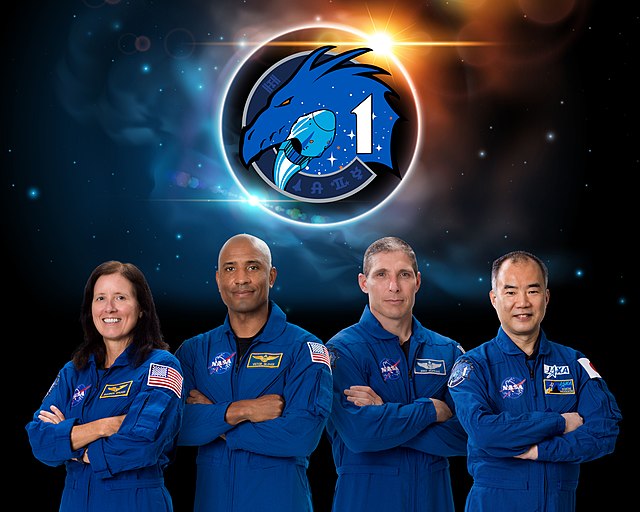Top Qs
Timeline
Chat
Perspective
SpaceX Crew-1
2020 American crewed spaceflight to the ISS and maiden flight of Crew Dragon Resilience From Wikipedia, the free encyclopedia
Remove ads
SpaceX Crew-1[6][7] (also known as USCV-1 or simply Crew-1)[8] was the first operational[b] crewed flight of a Crew Dragon spacecraft and the maiden flight of the Crew Dragon Resilience spacecraft. It was also the second crewed orbital flight launch by the United States since that of STS-135 in July 2011. Resilience launched on November 16, 2020, at 00:27:17 UTC[9][c] on a Falcon 9 from Kennedy Space Center Launch Complex 39A (LC-39A), carrying NASA astronauts Michael Hopkins, Victor Glover and Shannon Walker, along with JAXA astronaut Soichi Noguchi, all members of the Expedition 64 crew.[10][11] The mission was the second overall crewed orbital flight of the Crew Dragon.[12]
Crew-1 was the first operational mission to the International Space Station (ISS) in the Commercial Crew Program. Originally designated "USCV-1" by NASA in 2012, the launch date was delayed several times from the original date of November 2016.[13] The mission was scheduled to depart the ISS on April 28, 2021, but due to weather returned to Earth on May 2, 2021.[14][6][15] The capsule splashed down at 06:56:33 UTC, to be reused on Inspiration4.[16] It was the first nighttime splashdown for NASA astronauts since Apollo 8 in 1968.[17] On February 7, 2021, the Crew-1 broke the record for the longest spaceflight by a U.S. crewed vehicle, surpassing the 84-day mark set by an Apollo capsule on the final flight to the Skylab (Skylab-4) space station on February 8, 1974.[18]
Remove ads
Background
The first operational mission in the Commercial Crew Program, originally designated "USCV-1" (United States Crew Vehicle-mission 1) by NASA, was initially announced in November 2012, with a launch date set for November 2016.[13] In April 2013, it was announced that the launch would be delayed by one year to November 2017.[13] It was then delayed into 2019 and 2020, pending the success of the uncrewed and crewed demonstration missions, respectively. Following the Crew Dragon Demonstration Mission 2, Crew-1 was tentatively scheduled for September 2020; further delays occurred to align with the ongoing COVID-19 pandemic restrictions and their impact on the schedule of ISS crew rotations and cargo delivery missions,[16] and then again because of concerns about an issue with the gas generators on the Merlin 1D engines.[19]
On September 29, 2020, mission commander Michael Hopkins revealed during a NASA press conference that the capsule's crew had chosen to name it Resilience.[20] Due to the COVID-19 pandemic in Florida, the Kennedy Space Center Visitor Complex only allowed a few people to watch the launch in person from the KSC premises.[21]
Remove ads
Crew
NASA astronauts Michael S. Hopkins and Victor J. Glover were announced as the crew on August 3, 2018.[22] JAXA astronaut Soichi Noguchi and the third NASA astronaut, Shannon Walker, were added to the crew on March 31, 2020.[23][24][25]
Remove ads
Preparations
Summarize
Perspective
Crew-1's Falcon 9 launch vehicle arrived at Cape Canaveral, Florida, on July 14, 2020.[26] Crew Dragon capsule C207 arrived at SpaceX processing facilities in Florida, on August 18, 2020.[27][28] The successful launch of the Falcon 9 launch vehicle from Cape Canaveral Air Force Station (CCAFS) on November 5, 2020, was a milestone leading up to the Crew-1 mission. Falcon 9 successfully deployed a GPS navigation satellite (GPS III-04) for the United States Space Force (USSF), confirming that engineers had resolved an issue with Merlin 1D engines that delayed the GPS mission and the Crew-1 flight.[29]
The crew arrived at Kennedy Space Center via a NASA Gulfstream jet on November 8, 2020, at 13:53 UTC. A Flight Readiness Review (FRR) convened by NASA officials was scheduled on November 10, 2020, to discuss unresolved technical issues, review the status of launch preparations, and give approval for teams to proceed with the Crew-1 mission.[29] NASA officials gave approval on November 10, 2020, for SpaceX to begin regular crew rotation flights to the International Space Station, signaling a transition from development to operations for the human-rated Crew Dragon spacecraft.[30] The launch vehicle was lifted to its vertical position on the pad for a test firing of its Merlin-1D main engines on November 11, 2020, at 20:49 UTC.[31] A dry dress rehearsal (DDR) on November 12, 2020, saw the crew put on their pressure suits and climb into Resilience.[31] SpaceX ran a launch readiness review (LRR) on November 13, 2020.[32]
Mission
Summarize
Perspective


On November 15, 2020, final pre-launch preparations were completed. The hatch of Resilience was closed at 22:32 UTC, but reopened briefly after a slight drop in pressure was detected. Troubleshooting the hatch seal led to discovery of a small amount of foreign object debris (FOD) in the seal. The hatch was then closed again, and mission controllers proceeded with the countdown. No further concerns were noted, and on November 16, 2020, at 00:27:17 UTC, Resilience lifted off successfully. Its Falcon 9 first-stage booster, SN B1061.1, landed on the autonomous spaceport drone ship Just Read the Instructions.[9] The astronauts entered a stable orbit after about nine minutes. For this mission, the crew had chosen a plush toy of "The Child" (also known as "Baby Yoda") from The Mandalorian as a Zero-G indicator.[33] The crew were awakened on the second day of the flight with Phil Collins's "In the Air Tonight".[34]
Resilience docked to the International Docking Adapter (IDA) on the Harmony module on November 17, 2020, at 04:01 UTC.[2] Over the course of the mission, the four astronauts lived and worked alongside the three astronauts of the Soyuz MS-17 mission. Together, the two missions form ISS Expedition 64. Assuming the regular ISS crew rotation schedule is adhered to, the crew transfer to Expedition 65 following the departure of Soyuz MS-17, on April 17, 2021.[needs update]
On April 5, 2021, the Crew-1 astronauts relocated their spacecraft from Harmony forward to Harmony zenith by using the Draco thrusters that are mounted on the side of Dragon Resilience's trunk, to make way for the arrival and docking of the SpaceX Crew-2 spacecraft, launched on April 23, 2021.[35]
In July 2022, it was reported that some of the debris from Crew 1 Dragon crashed into a farm in Australia.[36][37]

Timeline
Remove ads
Gallery
See also
Wikimedia Commons has media related to SpaceX Crew-1.
Notes
- From an orbital dynamics perspective, the forward port is easier to approach, and therefore new vehicles use this approach for their first live docking. The Crew Dragon Endeavor made its second docking on Crew-2 on May 2, 2021; therefore, Crew-1 relocated to the zenith port to clear the forward port for Crew-2.[3]
- The Crew Dragon Demo-2 mission was the first crewed flight, but was considered as a test flight, not an operational flight
- 15 November 2020 19:27:17 Eastern Standard Time (EST), 16 November 2020 00:27:17 UTC
Remove ads
References
Wikiwand - on
Seamless Wikipedia browsing. On steroids.
Remove ads










